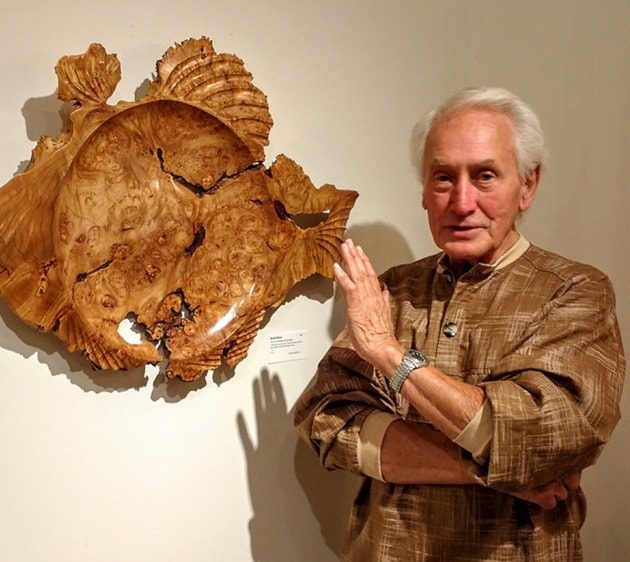By J. Kathleen Thompson
Should you find yourself in The West Gallery of gallery 2 in the next couple of months, you’ll have the extraordinary opportunity to take in a local woodturner’s final exhibition entitled “Turning Over.”
As it is an art form that is unfamiliar to many of us, woodturner Dave Milton suggests that the best way to access it is to listen to the stories inherent in the form at its most elemental; as a unique piece of wood.
The woodturner’s art begins at the moment of selecting the wood, when factors such as colour, grain, rings, distress points, texture, rot, crotch feathers and pressure ripples insinuate the life an artist will give it. The more “imperfections” in the wood, the more interesting it is to the discerning eye.
“There are many challenges to a tree’s existence. The character in a wood’s grain are a record of its struggle to survive and overcome stresses such as wind shear, fungi, pollarding, viruses, irregular growth, insects, malnutrition, water deprivation. Working simultaneously in both the stewardship role—appreciating the magnificence of this lifeform, and the artistic one—working creatively to reveal its hidden beauty, is the thing I love about this medium.”
Not uncommon, then, amongst the 40 pieces on display in “Turning Over” are articles which are organically connected to their source, such as “Universe in a Bowl” where exploding stars, black holes, nebula, clouds of colour and shimmering galaxies are all but illusions created by a highly textured piece of wood.
Similarly, the sculpted bowl entitled “Wind on Waves in Wood” grew from the wonderful motion inherent in the wood’s grain.
Another (“It was a Dark and Stormy Knight and Thereby Hangs a Tail”) was turned from a block of tulipwood which suggested the component parts of a medieval helmet: finial, dome, plates, etc. in its raw form.
“Turning Over” represents 60 years of Milton’s love affair with wood, and a journey which was rich in opportunity and adventure. It all began as a youngster in Britain, where, during the last gasps of the Industrial Revolution, standing in front of a lathe was a given for any schoolboy’s training.
Despite the equipment being antiquated, the requisite lathe-turning skills were taught and dutifully learned: spindle-turning, which is a technique for chair legs, rolling pins and the like, and face-plate turning, which is used for the hollowing of bowls, etc.
He still marvels at how, a product of a country struggling to modernize after a second devastating world war and simple working class parents, his life has had the abundance it has.
Milton’s working life alone was distinguished by its scope and variety. Beginning as a shipping clerk and customs agent at Heathrow Airport, a zest for travel and the outdoors led to a 10-year stint as an Outward Bound instructor in Europe and Africa and 25 years in animal husbandry (as a swine specialist) in Norway and Manitoba with his wife and two children.
A doctor’s recommendation that he find relief for his arthritis in warmer and drier climes led to eventual settlement and retirement in B.C. And time to return to woodturning.
The past 12 years in Grand Forks have been especially fruitful for Milton, allowing him to gainfully establish a woodworking presence both locally and internationally. Instrumental in initiating a number of woodworking fraternities, including the Boundary Woodworker’s Guild and the B.C. Wood Co-op, he also has found time to teach his craft, compete, exhibit and sell his work.
Full-time immersion in his workshop has also given him the space and time to venture beyond the standard realm of a woodturner’s craft into aeries reserved for the keenest of artistic visions. Case in point is Milton’s triptych of woodturned spiders, a subject which, given its delicacy, is seldom undertaken by woodturners. For Milton, it was an irresistible challenge.
“The spiders required a complexity of spindle work I don’t think has ever been done before. Each spider consists of about 40 individually turned elements to make their thoraxes, abdomens and legs, all of which are carefully fitted and glued together. I had a lot of fun doing this project; the story that emerged while I was working with them was that the three spiders—The Thinker, Flying Fish and Penny Red Legs—are caught in a web of spider intrigue revolving around who gets to go home with Penny Red Legs (and get eaten) for dinner! The ‘Singing Bowl’ she is playing is integral to the ploy!”
While much of Milton’s ‘oeuvre’ is available for purchase at the exhibit, a few have already been designated as gifts or donations, and one exquisitely turned bowl out of maple—“Parting Company”—will be raffled at $10 a ticket, the proceeds of which will go to gallery 2.
Enough to inspire you, I’m sure, to visit this one-of-a-kind exhibit during opening hours of the gallery (Tuesday - Fridays 10 a.m. – 4 p.m. and Saturdays 10 a.m. – 3 p.m.) Sept. 10 – Nov. 19. And to wish Milton well as he turns to other artistic interests (cello teachers, this may involve you!) in the next chapter of his life.
